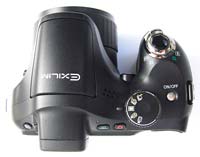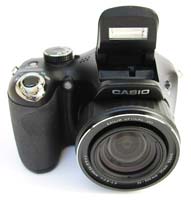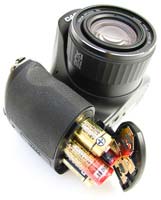Casio EXILIM Pro EX-FH20 Review
Review Date: November 19th 2008
Author: Gavin Stoker
Leave a comment about this review
|
Introduction

At first glance, the new Casio EXILIM Pro EX-FH20 looks similar to any other bridge-style compact camera, mimicking the look and feel of a beginner DSLR but offering an integrated 20x optical zoom lens (26-520mm equivalent). A 9 megapixel sensor, 3 inch LCD screen, 1cm macro mode and RAW file support complete the headline specs. But wait! Dig beneath the surface and you'll quickly find the real selling-point of the EX-FH20 - its incredible continuous shooting rate of up to 40fps for still images and 1000fps for video. Admittedly there's a drop in quality (to 7 megapixel stills and 224×56 pixel movies respectively), but the Casio EX-FH20 is easily the second fastest compact camera on the market, beaten only by it's big brother, the EX-F1, which is a lot more expensive and "only" offers 6 megapixels. Priced at £399 / $599, Gavin Stoker finds out if Casio's latest speed-demon can out-run the competition.
Compare Prices
Support PhotographyBLOG: Buy the Casio EXILIM Pro EX-FH20 from one of our affiliate retailers:Ease of Use
Though Casio arguably pioneered the slim-line compact we've all come to know and covet with its original Exilim models at the start of the millennium, it's fair to say that while they've looked stylish and incorporated some intriguing and innovative features, the Exilim range's performance when it comes to image quality has rarely been anything other than average. So, will the new DSLR-styled EX-FH20 bridge model that marries a 9.1 megapixel resolution to a 20x optical zoom (26-520mm equivalent), and boasts an impressive on paper continuous shooting speed of up to 40fps, buck the trend?
If nothing else the EX-FH20's specification list, which appears to focus as heavily on video capture as stills, with 1280x720 pixel HD footage offered at 30fps, proves that Casio, to an extent, is commendably still trying to up the ante and break from the crowd. It follows on from the spring release of the flagship 6MP, 12x optical zoom Exilim Pro EX-F1, which boasted 60fps, then and still the world's fastest offered by a compact camera. However, that camera was rather ambitiously priced in the region of £700, the EX-FH20 by contrast a much more modest – and realistic – £399. That said, it's still some £50 more expensive than similarly featured 20x optical zoom models from Canon and Olympus in the recently reviewed PowerShot SX10 IS and SP-570UZ respectively, and, of course costs the same as a beginner's DSLR with kit lens. So what else does the EX-FH20 have to make it extra special?
For starters the EX-FH20 boasts a large and firm, moulded handgrip, that, as with the Canon SX10 IS, stores the four alkaline AA batteries that power the camera in its base. Though the mostly-plastic camera feels lighter at 483g than both Canon and Olympus offerings even with power cells loaded, it's sufficiently solid to withstand the odd knock in the heat of the action, while its mottled matt black finish and subtle curves again consciously resembles DSLR design, even if this time around there's no hotshoe for supplementary flash. Like its two rivals, the EX-FH20 is too large for a jacket pocket, so a dedicated bag or attachment of the provided shoulder strap is required for portability.
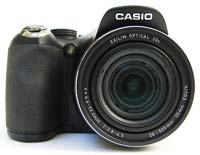 |
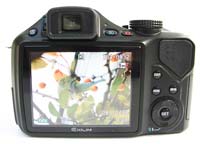 |
| Front | Rear |
There's a larger than average 3-inch LCD screen at the rear of the Casio EX-FH20 that takes up two thirds of the back plate's real estate. The fact that the monitor's ranged to the far left means that there's nowhere for your left hand to come to rest; to hold the EX-FH20 comfortably and firmly you have to place your thumb in the centre of the screen. The better alternative therefore is to hold the camera like a DSLR: wrap the fingers of your left hand around the stubby rubberised lens ring at the front while the thumb of your right hand comes to rest on a leather-look pad, top right hand side of the back. In this way the user's eye comes naturally to rest against the eye relief for the supplied electronic viewfinder ranged above and slightly to the left of the LCD. However visibility isn't the best we've seen, with a resolution of 201k in fact it's distinctly murky, whereas you have a larger and brighter fixed screen literally hitting you in the face (or rather nose) below.
Apart from the aforementioned lens which incidentally has easy-to-miss buttons for locking auto exposure and selecting macro mode set into the side of its barrel, plus the handgrip, the front of the EX-FH20 is fairly clean, featuring only a button for raising the spring-loaded pop up flash, plus a window for the AF assist/self timer bulb. On the forward slop of the handgrip is a large and springy shutter release button, encircled by a lever for the zoom. The EX-FH20's zoom is impressively quiet as it moves through its broad range, and very responsive and smooth too – it practically glides.
The EX-FH20 is however a tad slower than its rivals to power up, with a wait of around three seconds from pressing the recessed on/off button on the top plate to the lens barrel extending to maximum wide-angle and, finally, the rear LCD blinking into life enabling the user to compose the first shot. The camera is slightly faster when taking a shot, with little in the way of shutter delay and a momentary wait of a couple of seconds between shots at maximum resolution while the previous one is being committed to memory; here SD or higher capacity SDHC card.
Also on the top plate is a reassuringly stiff mode dial with definite 'bite' points, yet revealing just five shooting options: single shot stills capture, up to 40fps high speed continuous capture which requires a resolution drop to seven megapixels to achieve said speed, high speed continuous shooting with flash, HD or standard definition video, plus a further slow motion video option. Compared to the 13 shooting modes crammed around the same dial on Canon's SX10 IS, the Casio's therefore looks a tad unfinished.
|
The back of the EX-FH20 is similarly an exercise in minimalism, with a very 'spare' looking control layout and, given that, buttons surely smaller than they need to be – as it is they require fingertip operation. To the left of the electronic viewfinder we find a handily located dedicated button for switching between that and the LCD for shot composition. Just like on a fully blown DSLR, set into the ridge for the EVF is even a diopter adjustment wheel for use by the myopic. To the right hand side of the viewfinder are two further buttons – one for image playback and the adjacent one for image capture. Curiously, if you are reviewing recorded shots, a half press of the shutter release button won't bring you back to capture mode as it will on most competing models – you really do have to give the dedicated button a thumb press.
Mid right of the LCD screen are a brief cluster of controls. The top one is a self-explanatory 'display' button. Press this once and a live histogram showing individual red, green and blue channels on the left hand side joins the existing toolbar showing a vertical row of chosen shooting settings on the right, including the likes of image resolution (with the option of RAW + JPEG capture) and ISO speed (100-1600). Press this again and all shooting info disappears to leave only the central focus point indicated onscreen, which flashes from white to turquoise when focus has been determined. Equally obvious is the next button, for menu. Press this and you're presented with a choice of three equally straightforward folders onscreen: record, quality and set up. What's interesting is that this pops up as a window in the central portion of the screen, so you can still see what's going on in the scene before you – to an extent – at the same time.
Among the quality settings that basically control JPEG compression levels – fine, normal or economy – is the slightly more interesting dynamic range expansion control – with +1 or +2 settings offered. Similarly flash intensity can be manually tweaked, or the user can choose from a range of built-in coloured filters; useful if you feel a shot requires that element of drama but don't want to mess around trying to add it in Photoshop later. Set up thankfully allows the brightness of the EVF to be adjusted manually, along with house-keeping regulars such as changing date and time and formatting the card in use.
|
Adjacent to the menu button is a third marked simply 'BS' to amuse our readers in the States. In reality it stands for 'Best Shot' modes, a standout hand-holding feature of Casio digital cameras since the year dot. The EX-FH20 features some 18 of these pre-optimised settings, known as scene modes on rival models, with attractive onscreen thumbnails illustrating the subject each is best suited to. Alongside the more usual portrait and landscape settings are ones for children, autumn leaves, sunsets and fireworks, plus the ability to shoot multiple images and composite them into a single shot. If you want to switch from Best Shot mode back to regular capture however, you can't merely press the dedicated button twice to deactivate it or the image capture control illustrated with the red camera icon – slightly laboriously you have to tab through the icons on the on-screen toolbar to the right. I can imagine many users will therefore chance upon a Best Shot mode and then inadvertently leave the camera set to that setting forever more. Now that really is 'BS'.
Beneath the menu and BS buttons is a familiar four-way control pad for, in conjunction with the LCD or EVF, tabbing through images, settings and options, with a 'set' button thoughtfully located at its sensor for effecting any changes. At six 'clock on this dial is a dedicated setting for deleting duff shots, or, if in capture mode, jumping immediately to a pill-out toolbar displaying the flash settings: auto, off, forced or red eye reduction. And that's it for the rear of the camera. Generally, the EX-FH20 is as fast to respond as you'd expect a consumer camera to be, with, though a range of innovative features that just stay the right side of gimmickry, truly that whopper of a lens range as its stand out feature.
On the right hand side of the camera – if still viewing it from the back – is a slide and a flip open cover for the supplementary SD or SDHC card mentioned already, meaning that it can be accessed easily even when the EX-FH20 is mounted on a tripod. The left hand side, as expected, features a plastic flap protecting DC-in and USB/AV out ports, while up-ending the camera to examine its base reveals the equally expected screw thread for a tripod, next to a sliding cover for the battery compartment housing the four AAs provided. Budget for a set of rechargeables, as we almost got through two sets of AAs having taken just over 200 images.
So, while the Casio EX-FH20 itself is a mixture of standard features and prettified trimmings, how do the pictures themselves stand up?
|
![]() PhotographyBLOG
is a member of the DIWA
organisation. Our test results for the Casio EXILIM Pro EX-FH20 have been submitted to DIWA
for comparison with test results for different samples of
the same camera model supplied by other DIWA
member sites.
PhotographyBLOG
is a member of the DIWA
organisation. Our test results for the Casio EXILIM Pro EX-FH20 have been submitted to DIWA
for comparison with test results for different samples of
the same camera model supplied by other DIWA
member sites.

